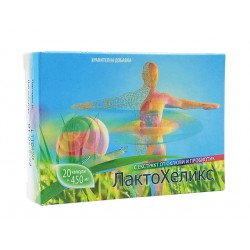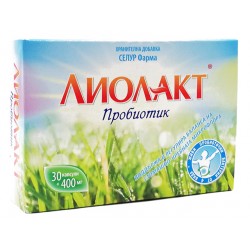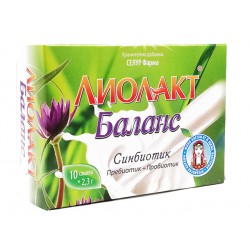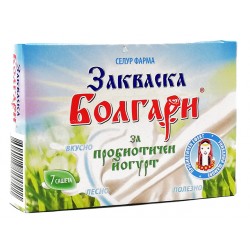Yulia Stoyanova is a biologist with a medical education. He works in the fields of virology, immunology, genetics, and other laboratory disciplines in active contact with different groups of patients.
The digestive system is home to more than 500 different types of bacteria that are part of the normal microflora. They conditionally belong to three main groups of microorganisms:
- Useful - they have a beneficial effect on the body. Their sufficient quantity determines the work of the digestive tract and the immune system.
- Conditionally pathogenic - under normal conditions, they do not cause disease, but if the body's defenses are impaired, they become pathogenic.
- Pathogenic – cause disease-causing processes. Intestinal flora is strongly
susceptible to external influences. Air pollution and the nature of which we are a part, stress, improper nutrition, antibiotics, and lack of sleep, literally kill the good bacteria in the body.
Probiotics are "good" or "friendly" bacteria, the most famous being Lactobacillus and Bifidobacterium. Experts believe that most strains of commonly studied species, such as Lactobacillus and Bifidobacterium, benefit the gut by creating a more favorable gut environment. More popular and common normal inhabitants of the intestine are the species Streptococcus thermophilus, Lactobacillus reuteri, and Lactobacillus casei, which are believed to support the good health of the intestinal mucosa, its functions, aid digestion, and support good immunity.
We can also usually find them in quality fermented products, for example, sauerkraut or yogurt. These bacteria are part of the beneficial composition of the human microbiome – the sum of all microorganisms living in the body and on the surface of a human individual. It is known that they are even more than the cells in the human body.
Probiotics are natural inhabitants of our living environment, often living on the foods themselves. Under favorable conditions for their development, they multiply, and fermentation is reached. Lactobacilli, for example, are found in yogurt as well as live on the surface of fruits and vegetables. Naturally, fermented foods have a sufficient amount of probiotics, unlike sterilized and commercial mass-produced foods.
Another very important aspect of the quality of fermented foods is that they retain their vitamin content, even enriched by the fermenting agents, unlike sterilized foods, where all microorganisms are killed and the vitamins in the food are destroyed by heat treatment. Most of them have the property of inhibiting the development of pathogens that have entered the body.
"The antimicrobial activity of beneficial bacteria is very important from the point of view of food safety. Various groups of lactic acid bacteria are used as biopreservatives. They are the main agents of biocontrol of food products, expressed in the use of living microbial cells or their metabolites, to suppress of the growth of other bacteria that have the same habitat but have a harmful effect. Viable lactobacillus cells in food products are a typical example of limiting, in a natural way, the development of spoilage or pathogenic microorganisms, through the synthesis of biologically active metabolites and changes in the general environment of the habitat. The most commonly used lactobacilli in biocontrol are L. caseri, L. delbrueckii bulgaricus and lactis, L. paracasei, L. plantarum, L. reuteri and L. sakei." / Prof. Georgieva and Prof. Danova, 2013. /
Chronology of the formation of the concept of probiotic and the development of the probiotic concept
(Year / Concept)
1953 Probiotics share common ingredients with vegetables - vitamins, aromatic substances, enzymes, and possibly other substances related to life processes
1954 Probiotics are seen as the opposite of antibiotics
1955 Harmful effects of antibiotics can be avoided by probiotic therapy
1965 Probiotics are substances secreted by some microorganisms that stimulate the growth of other microorganisms
1971 Probiotics are tissue extracts that stimulate microbial growth
1973 Probiotics are compounds that build the body's resistance to infection and do not inhibit the growth of microorganisms in vitro
1974 Microorganisms and substances relating to the intestinal microbial balance
1992 A live microbial nutritional supplement that benefits the body by improving the microbial balance
1993 A living mono- or mixed culture of microorganisms that has a beneficial effect on the body, improving the local microflora
1996 Live microbial culture or dairy product that healthily affects the body
1997 Live micro-organisms taken in sufficient quantity exhibit a health effect in addition to the main diet
1999 Microbial cell extracts beneficial to consumer health
2000 Microorganisms transiting the GI tract promote the health of the body
2001 Products containing certain live microorganisms in sufficient quantity, which affect the microflora through colonization, exhibit a beneficial and healthy effect on the body
2002 Probiotics are live microorganisms, taken in sufficient quantities, have a healthy effect on the body
/according to Prof. Georgieva and Prof. Danova, 2013/.
Based on the concept thus formed, a considerable number of microorganisms have been developed as probiotics. Some of them are additives to the food of people and animals, others for the treatment/prevention of various diseases, to overcome various physiological disorders and syndromes. Currently, several bacterial strains from different genera have been developed as probiotics, for example: Lactobacillus, Bifidobacterium, Bacillus, Streptococcus, Enterococcus, Lactococcus. In addition, the yeast strain Saccharomyces boulardii is recognized as a probiotic (Sanders, 2007).
"Several strains - classified as "resident" are more compatible and less antagonistic to other beneficial microorganisms permanently residing in the human body. This is a kind of evolutionarily fixed microbial association with a positive effect on the host organism. The following lactobacilli have been described as resident in humans: L. acidophilus, L. salivarius, L. fermentum, L. gasseri, and L. crispatus. Transit strains belonging to the species L. casei, L. delbrueckii, L. yogurti, L. brevis, L. kefir, and L. plantarum only temporarily reside in the intestinal tract, but for the transit time they can also have a positive effect.” /according to Assoc. Georgieva and Assoc. Danova 2013/
The World Health Organization's 2001 definition of probiotics is "that they are a group of microorganisms that, when administered in adequate amounts, are beneficial to the health of the body. To possess these beneficial properties, the microorganisms must be alive and available in large numbers during consumption.
Another requirement of probiotics is that they can survive in less than favorable conditions in the contents of the human gastrointestinal tract. Probiotic microorganisms are mainly of human and animal origin or from fermented foods.
Foods rich in probiotics:
Traditional Bulgarian:
- boza
- sour cream
- cheese
- sour cabbage
- yoghurt
- fermented flour
- fermented vegetables
- fermented porridge
- fermented butter
- sourdough bread
- apple vinegar
Others:
- beer, from root crops
- cocoa beans
- ketchup
- kefir
- sourdough
- kimchi
- kombucha
- miso
- ginger soda
- soy sauce
- tabasco sauce
- tempeh
- fermented lemons
In order for the desired probiotics to develop normally in food, the presence of prebiotics is also necessary.
What are prebiotics?
The most useful prebiotics are the indigestible oligosaccharides fructans and galactans. They are found in several foods, for example, mushrooms, wheat, rye, millet, garlic, onions, asparagus, tomatoes, artichokes, chicory, milk, etc.
Prebiotics and their sufficient amount in the environment are necessary for the good development of probiotics. Together, they ensure good gut health. This is one of the benefits of fermented foods – they are rich in probiotics.
In turn, some of them, for example beta-glucan, involved in the composition of the cell wall of yeast from p Saccharomyces trigger and stimulate non-specific immunity using Peyer's patches in the intestine.







